Your Strokes:
Megan Mathews Forehand
Analyzed by John Yandell
When my friend Gordon Collins, the Tennis Director at the Courtside Club in Los Gatos, California, called me to film Megan's forehand for him and his staff, I was impressed by her energy and athleticism.
To the naked eye her forehand also looked pretty darn good. Unlike the vast majority of the players I film, her first move was very strong and she completed the turn with her left arm stretched across the baseline and the shoulders fully turned. That was especially impressive for a woman--even on the tour you find few women who turn as fully as the men, Justine Henin-Hardenne being an exception. (Check it out in the Stroke Archive.)
If you looked at the path of Megan's swing it also appeared very free and ended with a full, relaxed wrap over her shoulder. But the critical times before and after the hit--what was really going on there? That's what the camera sees much more clearly. Megan had trouble controlling the pace and depth of her stroke and was inconsistent in matches.
When we looked at the video frame by frame before, during, and after the contact, we got some ideas why. Once we saw the problems in these key positions, we then compared then to high speed video of Andre Agassi's beautiful basic forehand motion. This helped Megan create a new model for the critical parts of the swing, and develop the corresponding mental images and feelings to use on the court.
First, let's look at two of Megan's forehands in the animation at regular speed. Can you see the difference between the two? You can probably see that the turn is there and the wrap is the same on both. Something else looks different in the foreswing, but what?
To really find out we have to look closely at the critical parts of the swing in slow motion: when the racket starts to the ball, and then moves through the contact zone. What the video shows is that on two very similar balls, her swing actually varied drastically. The difference is much greater than you would suspect watching in real time. Even though she still manages to wrap the finish in the same way on both, in the critical time around the hit, it looks almost as if she had two completely different forehands. And functionally speaking, she did.
On the first forehand, her racket slides to the side and actually opens after contact. On the second forehand, her hand and arm rotate over and across as she moves through the hitting zone. This ability to rotate the hand and arm can definitely be a positive factor, at least on some balls in an advanced forehand. But this was a basic ball in the center of the
The way Megan was timing the hand and arm rotation actually retarded her ability to do this. As you can see her contact is late, the rotation happens too fast and the result is that her extension is fatally restricted. If it seems hard to believe, yes, those really are the critical segments from those same two forehands you see running in real time above.
The video also showed that the problem with turning the hand over got worse when the ball was higher. Look on the third video segment what happens again on a basic ball in the center of the court that bounces up above waist level. You can see how her leverage decreases as the contact moves further back and she tries to compensate with the hand rotation.
After watching the video my conclusion was that she had way too much variation on her basic forehand drive. One of the Courtside pros, Cain Warwick, was feeding her balls throughout the filming, and although he moved her around, virtually all the balls were makeable balls that Megan should have been able to drive with authority.
The reality was there wasn't a single ball, where she really hit all the way through the shot and extended the universal finish position. This is the characteristic position that all good players reach when they are trying to hit a basic drive. (Click here to read about it in the article on forehand commonalities.)
When Megan saw herself side by side with Agassi, this was immediately clear to her. We went through frame by frame and saw how Andre set up the hitting arm position and how this was maintained through the hit as his racquet extended outward through the line of the shot, and across to the universal finish.
Megan could see that her extension was significantly less, and that especially on the high balls she was losing the hitting arm position in trying to turn the hand over. We also looked at how the hitting arm position was maintained at and through the contact point, and again, compared that to the way her hitting arm was collapsing and coming across the body too soon. That is the amazing power the imagery has. It gave Megan a crystal clear idea of where she was, and where she wanted to go.
The imagery is an equally powerful agent for making rapid physical change. This was the impact it had on Megan, as you can judge for yourself by looking at the "after" video. However it"s not just as simple as analyzing the video and developing some appropriate pro models. The key is to help the player incorporate the physical change. There is a specific process we use that maximizes the chance of a player moving his stroke closer to the model. To do this, the player has to actually recreate the key positions physically and learn to create the corresponding mental images.
In Megan''s case the place to start was with the finish. Using Agassi again as the model we went back to the court and created a physical finish position for her basic drive. These are the checkpoints: Wrist at about eye level. Racket and hand finishing across the body, and in line with the left shoulder. Forearm at about 45degrees and upper arm parallel to the court.
These checkpoints represent the point of maximum extension in the swing. It's the last point at which the racket is moving forward and/or upward before the start of the wrap. I had Megan create this position physically and learn the checkpoints. I then had her close her eyes and create the mental image. Then with her eyes still closed, she had to visualize the finish and physically swing her racket out over that image. This work with the eyes closed really helps to anchor both the image and the feeling that goes with it.
From there we backed the swing up to the contact point and did the same thing. Developed the checkpoints: elbow in, wrist laid back, plane of the racket at the edge or slightly in front of the front leg. Again she had to learn to move through the contact position (and then to the finish) with her eyes closed.
The final step in the process is to actively use the imagery when hitting real tennis balls. Obviously you need your eyes open for this part. But you can still visualize the key images and imagine them as a blueprint for the path of the racket. It goes like this: eye on the ball, mind's eye on the image of the key.
How did Megan do working with her images? I thought the result was amazing. Within a few dozen balls the motion had shifted. Within a few dozen more, the change looked almost totally natural.
Watch the after video in real time. Then watch the key parts of the forward motion in slow motion, Look at the extension prior to the wrap. Again, it's tough (if not impossible) to pick the difference in real time with the naked eye. But in slow motion you can see how she improved her core positions and was able to feel what it was really like to hit all the way through the ball. She had more depth, more consistency, and as much or more power.
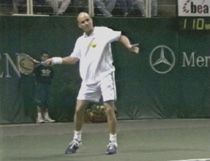 |
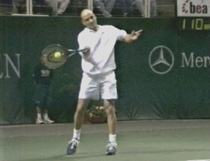 |
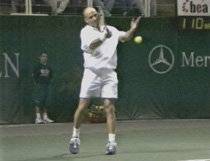 |
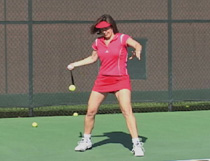 |
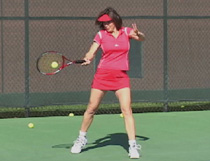 |
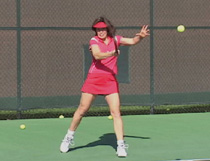 |
Megan moved the key positions in the stroke toward the Agassi model after hitting only a couple of hundred balls using on court visual imagery. |
||
Megan also reported that her stroke felt easier and more natural than before. Looking at her after video the difference is obvious, but I would like to see her work a little more on the double bend position at contact--moving the elbow in and letting the wrist fall back a little more. After that she can try to go back and reincorporate the extra hand rotation when appropriate, but still maintain the correct contact point and the extension in the stroke. It's interesting, but I see it again and again. Players think they are copying something great from the pros and by doing so, they undermine the fundamentals that form the basis for more advanced technique.




